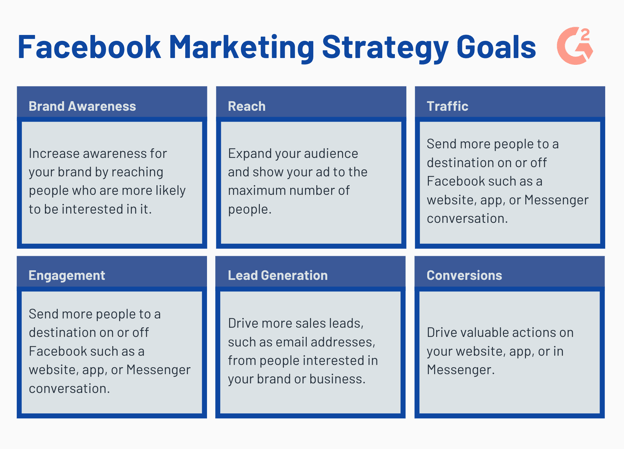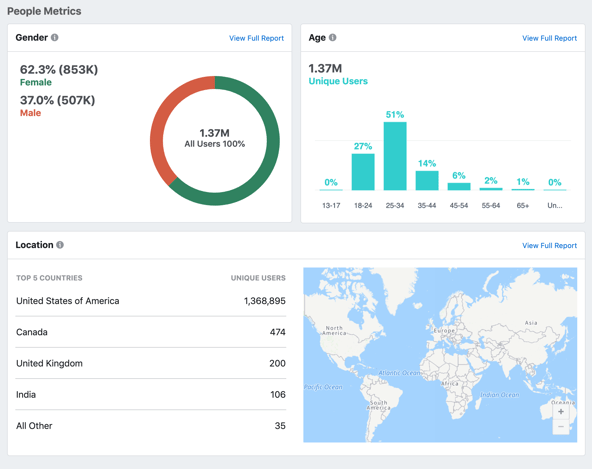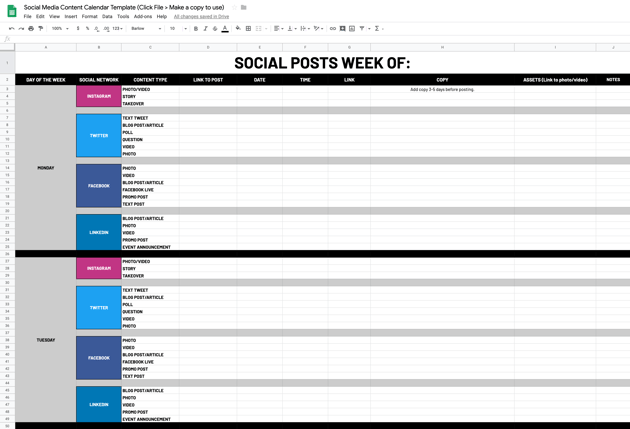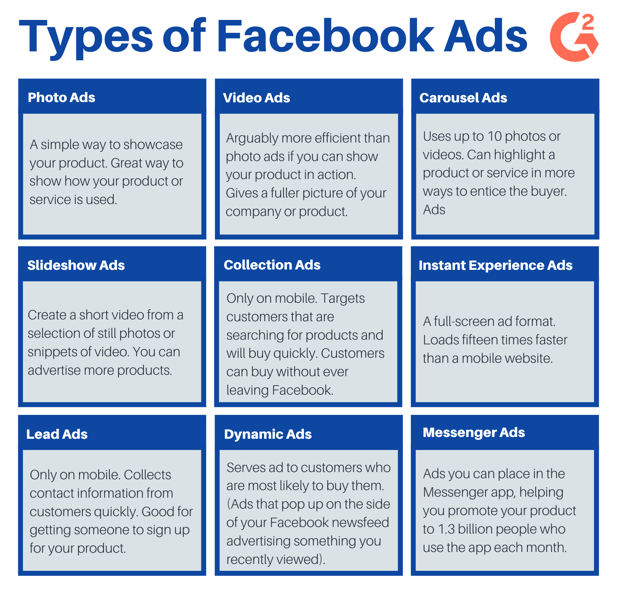May 15, 2019
 by Alexa Drake / May 15, 2019
by Alexa Drake / May 15, 2019

Facebook is massive. At this point, we all know this.
It’s obvious that Facebook has made its mark as one of the great social media giants, and it’s certainly not going anywhere. Marketers have been using Facebook in their social media marketing strategies ever since its creation in 2004. Developing a solid Facebook marketing strategy is crucial to your success on the platform.
A Facebook marketing strategy is your business’ approach to creating, planning, and posting valuable content on Facebook. The goal of a Facebook marketing strategy is to reach your target audience, improve brand awareness, and spread the word about your business on Facebook.
Every business’ Facebook marketing strategy is going to be different because each business will have different goals, objectives, and approaches. There’s a lot that goes into marketing and advertising on the platform, so that’s why we’ve created this guide. Keep reading to discover how you can develop your own unique Facebook marketing strategy.
If you’d like to learn about something in particular, feel free to skip ahead:
Create your goals
Observe your analytics
Create and schedule content
Develop a Facebook Ads strategy
Facebook has a huge audience with 1.5 billion users signing in every day. That’s a lot of people you could potentially be targeting on a daily basis. But keep in mind that there are thousands of businesses on the site already advertising to those people.
The idea of a Facebook marketing strategy may be intimidating at first, but once you assess what you want to accomplish while on the site, you can be certain that using it is more of a benefit than a burden.
Let’s start where every marketing strategy begins.
The first thing you should do when your business is creating a Facebook marketing strategy is to set some goals. Ask yourself what you want to accomplish on Facebook. Are you simply trying to spread the word about your business and increase brand awareness? Maybe you want to track leads and conversions or you’re hoping to increase traffic to your website.
No matter what you want to achieve, setting clear goals will keep you organized and focused throughout the campaigns or projects you carry out.
As mentioned before, every business will be different so there is not one universal goal when using Facebook. Some goals you could set could include:

Think of setting your business goals as the foundation of your Facebook marketing strategy. You can always keep yourself in check by remembering the SMART strategy.

For example, instead of setting your goal as increased brand awareness, you may set the SPECIFIC goal of gaining X amount of followers. The SMART strategy can go hand in hand with the Facebook marketing goals above. Take some time to think about what you want to accomplish on the platform. Knowing what you want and locking in a goal (or goals) will help you to stay focused and on-task as you carry out your marketing campaigns.
Understanding your audience is the best way to provide them with valuable and relevant content. Say you’re running an independent flower shop on Facebook. Your demographic will be wildly different to that of a tech startup. The better you can get to know who follows your Facebook page, the easier it will be to engage them.
This is where Facebook Analytics comes in handy.
To access your unique analytics, visit www.facebook.com/analytics and scroll to the bottom of the page.

By clicking any of the View Full Report buttons, you’ll be able to see a detailed overview of your business’ demographic.

Keeping things like Age & Gender, Country, City, and Language in mind as you build out your Facebook marketing strategy will help you to create content that resonates with the people that care about and follow your business.
For example, say you’re beginning a new campaign based around Mother’s Day flowers. If your audience is primarily based in San Francisco, you wouldn’t need to spend money on targeting people in New York or Dallas. Referencing your analytics on a consistent basis can help you make better decisions with your targeting, aim, and budget.
Check out our social media marketing hub for a plethora of additional resources.
Every social media platform has its own kind of content. Instagram has grid posts, Instagram Live, and Stories while Twitter has tweets and livestreams. Facebook has a few different styles of content that include image and video posts, Facebook Live, and Facebook Stories.
The content you produce and eventually post should be well thought out, timely, presentable, and most importantly, valuable to the consumer. When you’re in the process of creating content, always ask yourself:
| “What does my business do and who are we targeting?” |
Keeping this in the back of your mind at all times will ensure that you’re creating the right content for your audience.
No matter what industry you’re in, strategizing your posting schedule should always be a priority. Buffer reports:
| “Pages posting 5 times per day received an average of 2,466 engagements per post (a total of 12,330). Pages posting 10 or more times per day received an average of 1,202 engagements per post (a total of 12,020 engagements). In other words, posting 5 times per day appears to be the optimal Facebook posting frequency.” |
Perfecting your business’ unique posting schedule can take some time to nail so don’t get frustrated if you’re not seeing the engagement you want right away. Finding the best time to post on Facebook directly correlates with your analytics. After some trial and error, tracking your analytics to see when your audience is online, what they interact with, and the content types they like will aid you in your search for the perfect posting schedule.
Don’t give up, it takes time!
When you start to understand the content that serves your business as well as your audience best, consider implementing a social media calendar into your marketing strategy.
While you may be dedicated to your business, the world of marketing is hectic and things can be forgotten. The purpose of a social media calendar is to organize your posts in advance, like scheduling Facebook posts, so that you’re able to publish content when it’s relevant for your business.
Maybe you’re the founder of a popular burger joint. Planning posts around #NationalBurgerDay ahead of time will allow you to get those posts ready to share on social and allows you to continue focusing on bigger projects you may have in the works.

If you’re interested in downloading our social media calendar, click here. Come on, it’s free.
We’ve talked about targeting your audience and serving relevant content, so let’s discuss your Facebook Ads strategy.
Advertising on any social media platform can be exhausting and tricky, but taking the time to craft a solid ad strategy can take you a long way. First and foremost, you’ll need to familiarize yourself with the types of Facebook ads that are available to you.

Because there are nine ad formats to choose from, business owners can truly customize their ad strategy however they see fit. In the beginning, you may try out a couple different formats to help you determine if one type performs better for your business than another. Having this knowledge will help you to engage with your audience more effectively.
Advertising on Facebook is all about reaching more people. Your ad strategy should always aim to get your content in front of more eyes and hopefully get them to engage or convert.
When first developing your Facebook ads strategy, you should be focusing on making them relevant, timely, and cost-effective. No one likes spending more money on ads then they need to. Readjusting your target audience can guarantee you don’t waste your budget reaching people that don’t care about your business.
Being cost-effective directly relates to being relevant. Serving your ads to a wide audience isn’t necessarily a bad thing, but it can waste lots of ad spend. At first, target a small audience and build a solid connection with them. After you understand who wants to see your ads, you can gradually widen your target audience.
Click through to learn everything you need to know about how to advertise on Facebook.
While you may have a vision of what you want your company to achieve on Facebook, it often takes time to perfect your marketing strategy. Nonetheless, paying attention to and monitoring your goals, analytics, content, and ad campaigns are some of the most important factors that play a part in your overall success on Facebook.
Translating your business onto social media can be daunting, but if you are constantly learning how to better serve your audience, you’ll see increased brand awareness, conversions, and engagement in no time.
Interested in becoming a social media pro? Read up on LinkedIn marketing or on developing a killer Instagram marketing strategy.
Alexa is a former content associate at G2. Born and raised in Chicago, she went to Columbia College Chicago and entered the world of all things event marketing and social media. In her free time, she likes being outside with her dog, creating playlists, and dabbling in Illustrator. (she/her/hers)
Ask any marketer and they’ll tell you – you’re only as good as the data you have.
 by Holly Landis
by Holly Landis
When you’re clear on your purpose, your work gets clearer, too.
 by Sarah Brooks
by Sarah Brooks
Ask any marketer and they’ll tell you – you’re only as good as the data you have.
 by Holly Landis
by Holly Landis



